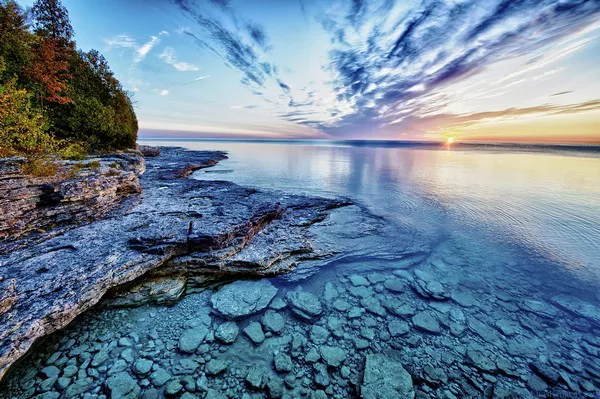Lakes, with their tranquil waters and scenic surroundings, hold a special place in the natural landscape of our planet. From expansive bodies of water to hidden gems nestled in remote regions, lakes are not only beautiful but also play a vital role in supporting ecosystems and human livelihoods. In this article, we will delve into the top 11 countries with the most lakes in the world, exploring their diverse aquatic environments and the significance of lakes within their borders.
Top 11 Countries with the Most Lakes in the World
1. Canada
Total Number of Lakes: Estimated at over 2 million
Canada, known for its vast wilderness and abundant freshwater resources, tops the list as the country with the most lakes in the world. From the iconic Great Lakes to remote glacial lakes in the northern regions, Canada’s landscape is dotted with countless bodies of water.
The Great Lakes, shared with the United States, are the largest group of freshwater lakes on Earth and include Lake Superior, Lake Michigan, Lake Huron, Lake Erie, and Lake Ontario. These interconnected lakes not only provide valuable freshwater resources but also support diverse ecosystems and recreational activities.
In addition to the Great Lakes, Canada is home to numerous other lakes, including the massive Great Bear Lake and Great Slave Lake in the Northwest Territories, as well as thousands of smaller lakes scattered across the country’s vast territory.
2. Finland
Total Number of Lakes: Estimated at over 187,000
Finland, known as the “Land of a Thousand Lakes,” boasts an extensive network of lakes that cover approximately 10% of its total land area. These lakes, formed by glacial activity during the last Ice Age, are a defining feature of Finland’s landscape and play a central role in the country’s culture and economy.
The largest lakes in Finland include Lake Saimaa, the country’s largest lake by area, and Lake Päijänne, known for its clear waters and scenic beauty. These lakes, along with countless others, provide important habitats for wildlife, support recreational activities such as boating and fishing, and serve as sources of drinking water and hydropower.
3. Russia
Total Number of Lakes: Estimated at over 160,000
Russia, with its vast territory spanning multiple climatic zones, is home to a diverse array of lakes, ranging from small inland ponds to massive bodies of water in the northern regions. Lakes play a crucial role in shaping Russia’s landscape and supporting biodiversity, particularly in remote and sparsely populated areas.
The largest lake in Russia is Lake Baikal, often referred to as the “Pearl of Siberia.” Located in the southern part of Siberia, Lake Baikal is not only the deepest and oldest freshwater lake in the world but also one of the most biologically diverse. It is home to thousands of plant and animal species, many of which are found nowhere else on Earth.
In addition to Lake Baikal, Russia is home to numerous other lakes, including the Caspian Sea, the largest inland body of water on Earth, and Lake Ladoga, Europe’s largest lake by surface area.
4. Sweden
Total Number of Lakes: Estimated at over 100,000
Sweden, with its abundance of forests, mountains, and waterways, is renowned for its picturesque lakeshores and pristine natural landscapes. Lakes cover approximately 9% of Sweden’s total land area, providing important habitats for wildlife and offering opportunities for recreation and relaxation.
The largest lake in Sweden is Lake Vänern, located in the southwestern part of the country. Lake Vänern is not only Sweden’s largest lake by surface area but also the third-largest lake in Europe. It supports a rich diversity of fish species and serves as an important transportation route for shipping and commerce.
In addition to Lake Vänern, Sweden is home to numerous other lakes, including Lake Vättern, Lake Mälaren, and Lake Hjälmaren, each with its own unique characteristics and ecological significance.
5. Norway
Total Number of Lakes: Estimated at over 450,000
Norway, with its rugged mountains, deep fjords, and pristine wilderness, is home to a vast number of lakes that dot the landscape. These lakes, formed by glacial activity during the Ice Age, are a prominent feature of Norway’s natural environment and play a crucial role in supporting ecosystems and human activities.
The largest lake in Norway is Lake Mjøsa, located in the eastern part of the country. Lake Mjøsa is not only Norway’s largest lake by surface area but also one of the deepest lakes in Europe. It supports a variety of fish species and serves as a popular destination for boating, fishing, and recreational activities.
In addition to Lake Mjøsa, Norway is home to numerous other lakes, including Lake Randsfjorden, Lake Femunden, and Lake Tyin, each offering its own unique scenery and opportunities for outdoor adventure.
6. Brazil
Total Number of Lakes: Estimated at over 100,000
Brazil, known for its vast rainforests and extensive river systems, is also home to a significant number of lakes that dot the landscape. While Brazil is often associated with its iconic rivers such as the Amazon and the Paraná, lakes play an important role in supporting biodiversity and providing valuable habitats for wildlife.
The largest lake in Brazil is Lake Paranoá, located in the capital city of Brasília. Lake Paranoá is an artificial reservoir created by the construction of the Paranoá Dam and serves as a popular recreational destination for residents and visitors alike.
In addition to Lake Paranoá, Brazil is home to numerous other lakes, including Lake Balbina, Lake Tucuruí, and Lake Sobradinho, each contributing to the country’s rich natural heritage.
7. United States
Total Number of Lakes: Estimated at over 100,000
The United States, with its diverse geography and vast expanse of land, is also home to a significant number of lakes that vary in size, shape, and ecological importance. From the Great Lakes in the Midwest to the glacial lakes of the northern states, lakes are a prominent feature of the American landscape.
The Great Lakes, shared with Canada, are the largest group of freshwater lakes on Earth and include Lake Superior, Lake Michigan, Lake Huron, Lake Erie, and Lake Ontario. These interconnected lakes not only provide valuable freshwater resources but also support a wide range of recreational activities and commercial shipping.
In addition to the Great Lakes, the United States is home to numerous other lakes, each with its own unique characteristics and ecological significance. One notable example is the Great Salt Lake in Utah, which is the largest saltwater lake in the Western Hemisphere. The Great Salt Lake, known for its high salinity levels, supports unique ecosystems and serves as an important habitat for migratory birds.
Other prominent lakes in the United States include Lake Tahoe, located on the border between California and Nevada, which is known for its crystal-clear waters and stunning alpine scenery. Additionally, the Finger Lakes region in upstate New York is famous for its series of long, narrow lakes formed by glacial activity.
Overall, lakes in the United States play a crucial role in supporting biodiversity, providing recreational opportunities, and serving as important water sources for both human consumption and agricultural irrigation.
8. Kazakhstan
Total Number of Lakes: Estimated at over 48,000
Kazakhstan, the largest landlocked country in the world, is also home to a significant number of lakes that dot its vast steppes and deserts.
One of the most famous lakes in Kazakhstan is Lake Balkhash, located in the southeastern part of the country. Lake Balkhash is the largest lake in Kazakhstan by surface area and is known for its unique geological features, including a divided basin that separates the lake into distinct eastern and western parts.
Another notable lake in Kazakhstan is Lake Zaysan, located in the eastern part of the country near the border with China. Lake Zaysan is an important water source for local communities and supports a variety of fish species, including carp and sturgeon.
In addition to these larger lakes, Kazakhstan is home to thousands of smaller lakes and reservoirs that play important roles in supporting agriculture, providing drinking water, and sustaining local ecosystems.
9. Argentina
Total Number of Lakes: Estimated at over 30,000
Argentina, with its diverse landscapes ranging from the Andes Mountains to the Pampas grasslands, is also home to a significant number of lakes that contribute to the country’s natural beauty and ecological diversity.
One of the most iconic lakes in Argentina is Lake Buenos Aires, also known as Lake General Carrera, which straddles the border with Chile. Lake Buenos Aires is the largest lake in Argentina by surface area and is renowned for its turquoise-blue waters and stunning mountain scenery.
Another notable lake in Argentina is Lake Nahuel Huapi, located in the Patagonian region of the country. Lake Nahuel Huapi is surrounded by snow-capped peaks and dense forests, making it a popular destination for outdoor enthusiasts and nature lovers.
In addition to these larger lakes, Argentina is home to thousands of smaller lakes and lagoons that support diverse ecosystems and provide important habitats for wildlife.
10. China
Total Number of Lakes: Estimated at over 25,000
China, with its vast landmass and diverse geography, is home to a significant number of lakes that vary in size, shape, and origin. Lakes in China are found in various regions, from the Tibetan Plateau to the densely populated eastern provinces.
One of the most famous lakes in China is Lake Poyang, located in the southeastern province of Jiangxi. Lake Poyang is the largest freshwater lake in China and serves as an important habitat for migratory birds, particularly during the winter months.
Another notable lake in China is Lake Tai, located near the city of Suzhou in the eastern province of Jiangsu. Lake Tai is known for its scenic beauty and cultural significance, with numerous historic sites and temples located along its shores.
In addition to these larger lakes, China is home to thousands of smaller lakes and reservoirs that play important roles in supporting agriculture, industry, and urban development.
11. India
Total Number of Lakes: Estimated at over 20,000
India, with its diverse landscapes and rich cultural heritage, is also home to a significant number of lakes that provide important ecological, cultural, and recreational benefits.
One of the most famous lakes in India is Lake Dal, located in the northern state of Jammu and Kashmir. Lake Dal is known for its picturesque surroundings and floating gardens, which are created by local residents to cultivate vegetables and flowers.
Another notable lake in India is Chilika Lake, located in the eastern state of Odisha. Chilika Lake is the largest coastal lagoon in India and is recognized as a Ramsar Wetland of International Importance. It supports a rich diversity of flora and fauna, including migratory birds and endangered species such as the Irrawaddy dolphin.
In addition to these larger lakes, India is home to thousands of smaller lakes and reservoirs that play important roles in supporting agriculture, providing drinking water, and regulating local climates.
See Also: 10 Most Powerful Countries In The Middle East
Conclusion
Lakes are not only beautiful natural features but also important ecosystems that support a wide range of plant and animal species. The top 11 countries with the most lakes in the world, including Canada, Finland, Russia, Sweden, Norway, Brazil, the United States, Argentina, China, India, and Kazakhstan, are home to some of the most stunning and diverse aquatic environments on the planet.
You Might Be Interested In:

























